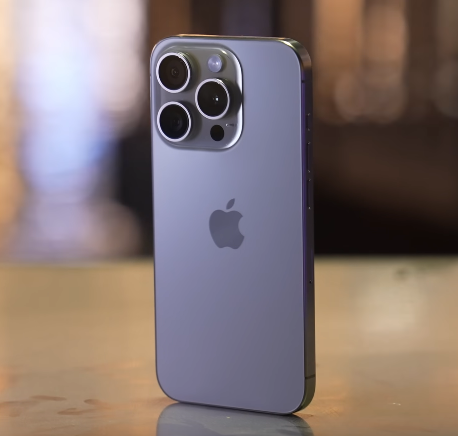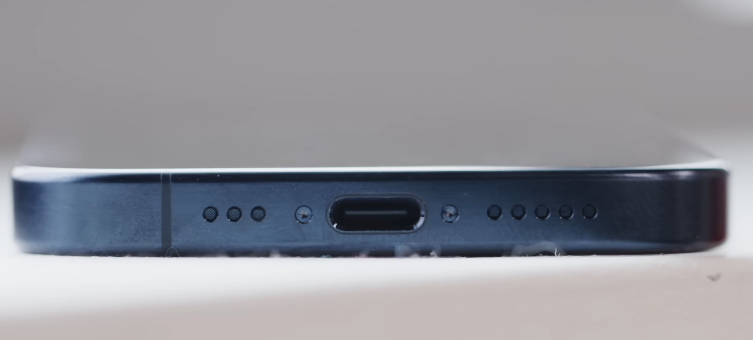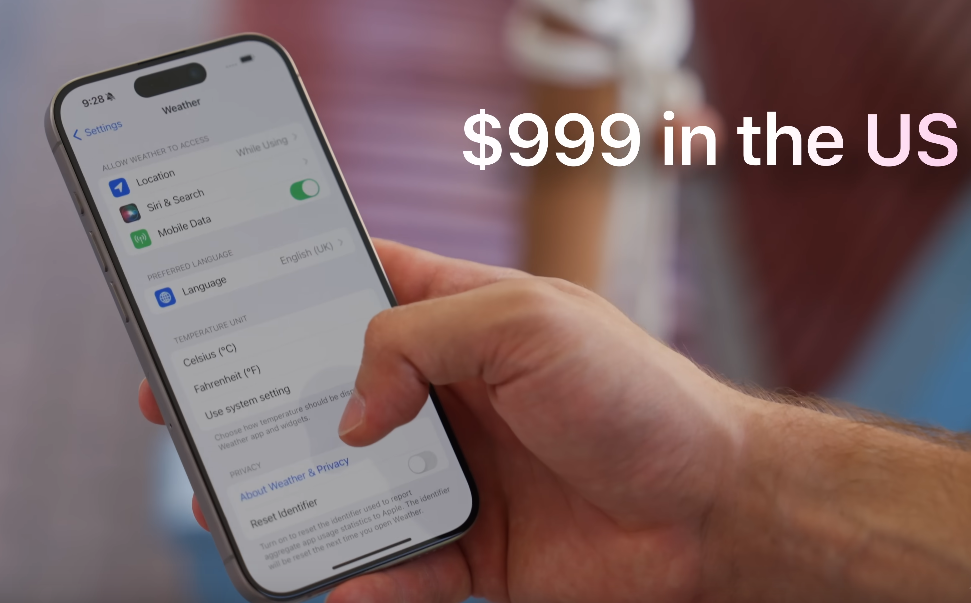When you first look at the iPhone 15 Pro and 15 Pro Max, you might not be immediately wowed by a standout feature. Unlike their predecessors, which boasted dynamic features like the Dynamic Island on the iPhone 14 Pros or the impressive 120Hz ProMotion displays on the iPhone 13 Pros, these new iPhones seem somewhat forgettable. Even the famous Apple product summary page for these phones had many features that felt familiar. Plus, there’s no bold new color to distinguish them aesthetically. In many ways, this is one of the driest iPhone releases in recent memory.
However, as you spend more time with the iPhone 15 Pro and 15 Pro Max, you begin to notice the little things. These subtle details, not always highlighted by Apple, come together to create a surprisingly beneficial experience, especially when it comes to the cameras.
Unboxing the iPhone 15 Pro
Opening the box, you’ll find the phone, a new USB-C cable with a durable woven fiber sheath, and the usual accessories like the SIM ejector tool, manual, and Apple stickers.
The Action Button
One of the standout features is the action button. It replaces the Ring/Silent switch and can be programmed for various functions. While it might seem redundant with the triple-tap feature on the power button, it’s more convenient for quick camera access. Its location could be more ergonomic, but it offers potential for creative control, and Apple didn’t make a big deal about it.
Call Quality
Call quality on the iPhone 15 Pro has received an improvement, particularly in voice isolation. Background noise is significantly reduced, and the voice effects persist across different communication apps.
Performance: iPhone 15 Pro
Under the hood, the new A17 Pro chip offers around 10% more CPU power and a 20% boost in graphics compared to the previous generation. This enhanced performance, along with the higher-quality display, allows for console-like gaming experiences on your phone.
Design: iPhone 15 Pro
The iPhone 15 Pros feature a sleek design with contoured edges, making them more comfortable to hold. The switch to titanium and a matte finish improves durability and reduces fingerprint smudges. The slim bezels contribute to a more immersive viewing experience.
Cameras: iPhone 15 Pro
The camera system is where these iPhones shine. It’s not about one individual feature but how they all work together seamlessly. The phones take 48-megapixel photos by default, and the images are detailed and high-quality. Portrait mode is more versatile, and the improved HDR delivers better results. The ability to capture 24-megapixel photos in auto mode is a noteworthy feature.
Zoom Capabilities
While Apple touts the iPhone 15 Pro as having seven lenses, this is a bit misleading. The optical zoom only covers a limited range between 1x and 2x, and the rest relies on digital zoom. However, it’s still a great zoom camera, and you can achieve flattering portraits even at 3x or 5x zoom levels.
Battery Life
Battery life has been a concern for some users in recent iPhone models, but the iPhone 15 Pros come with larger batteries, more mature software, and better heat dissipation, which should lead to improved battery longevity.
USB-C Connectivity
The adoption of USB-C brings more stability and compatibility with various accessories. iPhones can now reverse charge other devices, making you less likely to be the “battery lead” in your group.
Price
The iPhone 15 Pro retains the $999 price point, while the Pro Max is priced at $1,199. The Pro Max offers more storage and a 5x optical zoom lens for the extra cost, but whether it’s worth the upgrade depends on your specific needs and preferences.
Summary
The iPhone 15 Pro and 15 Pro Max may not have a single groundbreaking feature, but their seamless integration of camera capabilities and various improvements make them a compelling choice for those looking for an all-around high-quality smartphone experience. Battery life and the introduction of USBC are additional advantages. However, the decision between the two models will largely depend on individual needs and budget considerations.
iPhone 15 Specifications
| Feature | Specification |
|---|---|
| 📡 Network Technology | GSM / CDMA / HSPA / EVDO / LTE / 5G |
| 📅 Launch Announced | 2023, September 12 |
| 📅 Status | Available. Released 2023, September 22 |
| 📐 Dimensions | 146.6 x 70.6 x 8.3 mm (5.77 x 2.78 x 0.33 in) |
| ⚖️ Weight | 187 g (6.60 oz) |
| 🏗️ Build | Glass front (Corning-made glass), glass back (Corning-made glass), titanium frame (grade 5) |
| 📱 SIM | Nano-SIM and eSIM – International |
| 📱 | Dual eSIM with multiple numbers – USA |
| 📱 | Dual SIM (Nano-SIM, dual stand-by) – China |
| 🌊 Water & Dust Resistance | IP68 dust/water resistant (up to 6m for 30 min) |
| 💳 Apple Pay | Visa, MasterCard, AMEX certified |
| 📺 Display Type | LTPO Super Retina XDR OLED, 120Hz, HDR10, Dolby Vision, 1000 nits (typ), 2000 nits (HBM) |
| 📏 Size | 6.1 inches, 91.3 cm² (~88.2% screen-to-body ratio) |
| 📐 Resolution | 1179 x 2556 pixels, 19.5:9 ratio (~461 ppi density) |
| 🔐 Protection | Ceramic Shield glass |
| 📱 Always-On Display | Yes |
| 📟 OS | iOS 17, upgradable to iOS 17.0.3 |
| 🧰 Chipset | Apple A17 Pro (3 nm) |
| 💻 CPU | Hexa-core (2×3.78 GHz + 4×2.11 GHz) |
| 🎮 GPU | Apple GPU (6-core graphics) |
| 📚 Memory | Card Slot: No |
| 📚 | Internal: 128GB 8GB RAM, 256GB 8GB RAM, 512GB 8GB RAM, 1TB 8GB RAM, NVMe |
| 📷 Main Camera | Triple: 48 MP, f/1.8, 24mm (wide), 12 MP, f/2.8, 77mm (telephoto), 12 MP, f/2.2, 13mm, 120˚ (ultrawide), TOF 3D LiDAR scanner (depth) |
| 📸 Camera Features | Dual-LED dual-tone flash, HDR (photo/panorama) |
| 🎥 Video | 4K@24/25/30/60fps, 1080p@25/30/60/120/240fps, 10-bit HDR, Dolby Vision HDR (up to 60fps), ProRes, Cinematic mode (4K@24/30fps), 3D (spatial) video, stereo sound recording |
| 🤳 Selfie Camera | Single: 12 MP, f/1.9, 23mm (wide), SL 3D, (depth/biometrics sensor) |
| 🤳 Selfie Camera Features | HDR, Cinematic mode (4K@24/30fps) |
| 🔊 Loudspeaker | Yes, with stereo speakers |
| 🎧 3.5mm Jack | No |
| 🌐 WLAN | Wi-Fi 802.11 a/b/g/n/ac/6e, dual-band, hotspot |
| 📶 Bluetooth | 5.3, A2DP, LE |
| 🛰️ Positioning | GPS (L1+L5), GLONASS, GALILEO, BDS, QZSS, NavIC |
📡 NFC |
Yes |
| 📻 Radio | No |
| 🪙 USB | USB Type-C 3.2 Gen 2, DisplayPort |
| 🌡️ Sensors | Face ID, accelerometer, gyro, proximity, compass, barometer, Ultra Wideband 2 (UWB) support, Emergency SOS via satellite (SMS sending/receiving) |
| 🔋 Battery Type | Li-Ion 3274 mAh, non-removable |
| 🔌 Charging | Wired, 50% in 30 min (advertised), 15W wireless (MagSafe), 7.5W wireless (Qi), 4.5W reverse wired |
| 🌈 Colors | Black Titanium, White Titanium, Blue Titanium, Natural Titanium |
| 📋 Models | A2848, A3101, A3102, A3104, iPhone16,1 |
| 📡 SAR | 1.14 W/kg (head) |
| 📡 SAR EU | 0.98 W/kg (head) |
| 💲 Price | $999.99 / €1,199.00 / £999.00 |
| 🧪 Tests | Display: Contrast ratio: Infinite (nominal), Camera: Photo / Video, Loudspeaker: -26.4 LUFS (Good) |
| 🔋 Battery Life | Endurance Rating: 86h |
The Review
iPhone 15 Pro
The iPhone 15 Pro is a top-tier smartphone offering from Apple, boasting impressive features and specifications. It features a powerful A17 Pro chipset and an advanced camera system with a 48 MP main camera. The device also comes with a stunning LTPO Super Retina XDR OLED display, offering HDR10 and Dolby Vision support. The iPhone 15 Pro supports 5G connectivity, and it's equipped with an efficient Li-Ion battery that supports fast charging. Additionally, its durable build, water and dust resistance, and various storage options make it a versatile and high-end choice for tech enthusiasts.
PROS
- Powerful Performance: The device is equipped with the Apple A17 Pro chipset, ensuring snappy and efficient performance for various tasks and applications.
- Stunning Display: The LTPO Super Retina XDR OLED display offers a high resolution, excellent color accuracy, and support for HDR content, providing a visually appealing experience.
CONS
- Price: The iPhone 15 Pro is a premium smartphone, and its price reflects that. It may not be budget-friendly for many consumers.
- Battery Capacity: While the device comes with a decent battery, some users may prefer larger battery capacities for extended usage without recharging.
Review Breakdown
-
Camera
-
CPU
-
Display
-
Design










Comments 2